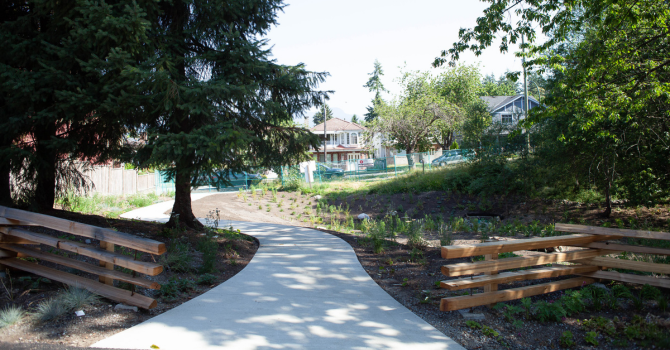
 Newly opened "Gibby’s Field" adds green space and rainwater management to East Vancouver
Newly opened "Gibby’s Field" adds green space and rainwater management to East Vancouver
Community members, schoolchildren and elected officials gathered today to celebrate the opening of a new park in the Kensington-Cedar Cottage neighbourhood.
Known locally as “Gibby’s Field”, the small (0.15 ha) parcel of land is the last remaining section of the historical Gibson’s Creek, at one time the longest creek in the China Creek system. Once a thriving waterway populated by salmon, trout, lamprey and stickleback, Gibson’s Creek became one of several creeks and streams piped, buried, and lost to urban development in the early 20th century.
A century later, a passionate local neighbourhood group began advocating for the preservation of this area as a community green space and in 2020, Park Board acquired the land and began work with staff from the City’s Green Infrastructure team to design, fund, and build Gibby’s Field.
The new park features an accessible pathway with natural vegetation and green rainwater infrastructure, including an engineered wetland designed to meet Rain City Strategy targets to capture and clean 90% of annual rainfall in a year.
Rainwater runoff will be collected from the laneway catch basin and conveyed into the wetland, where plants and soils will help to filter out pollutants such as heavy metals, bacteria, chemicals, and microplastics before water returns into the ground.
New trees and over 60 types of native and culturally significant plants have been added to the park. Temporary fencing is in place in some sections of the park to help plants establish in their first seasons of growth.
An official park name will be identified at a future date through the Park Board’s collaborative work with the local First Nations.
The development and construction of Gibby’s Field was made possible through a variety of funding sources including the City of Vancouver’s Capital Plan and the Government of Canada's Natural Infrastructure Fund. In 2023, the Federal Government announced a contribution of $18.9 million to the City of Vancouver and Park Board to help expedite green rainwater infrastructure projects across the city. The Capital Plan is Vancouver’s four-year road map for making significant investments in infrastructure and amenities.
Quotes
“This new park not only offers a beautiful space for the community to enjoy, but also helps create healthier ecosystems and cleaner waterways across our city,” says Mayor Ken Sim. “Gibby’s Field shows that, big or small, every step we take contributes to a lasting environmental legacy - one that will benefit future generations and help build a more sustainable and vibrant Vancouver.”
“The Park Board is proud to have supported the vision of this passionate local community,” says Park Board Chair Brennan Bastyovanszky. “Gibby’s Field is an exciting new chapter in the story of a small but mighty green space and I can’t wait to see this wonderful park flourish as a thriving natural and community space.”
“Gibby’s Field, an area with rich history in the Kensington-Cedar Cottage neighbourhood, has been preserved through local dedication,” says the Honourable Dr. Hedy Fry, Member of Parliament for Vancouver Centre, on behalf of the Honourable Sean Fraser, Minister of Housing, Infrastructure and Communities. “Now, as part of Vancouver’s key Rain City Strategy initiative, this new park will improve rainwater management and support biodiversity, reflecting our shared commitment to a greener, more resilient city. We look forward to ongoing collaboration to strengthen climate resilience across Vancouver and ensure a sustainable future for all residents.”
Green Rainwater Infrastructure in East Vancouver
Gibby’s Field is a new connection point in this blue-green system and one of several green rainwater infrastructure projects that have been implemented in East Vancouver over the past few years. This includes a half-block rain garden at Woodland and 2nd Ave PDF file (2.7 MB) that filters 3800 m3 of rainwater each year and seven small rain gardens at street corners that intercept and filter rainwater while adding green space to the neighbourhood.
Along with Gibby’s Field, these sites are helping to contribute to a connected network for rainwater management and biodiversity in the city.
Daylighting Vancouver
Vancouver was once a temperate rainforest with an extensive network of natural streams and creeks. As the city developed and grew, these waterways were directed into pipes, filled in or diverted to manage rainwater and wastewater.
The Park Board and City of Vancouver are committed to exploring more naturalized drainage and flood management approaches, including daylighting, restoring ecological processes, and integrating native plant species across the city.
Daylighting work was completed earlier this year at Tatlow and Volunteer parks and work is underway to restore sections of Still Creek (east Vancouver) and Canyon Creek (Spanish Banks).